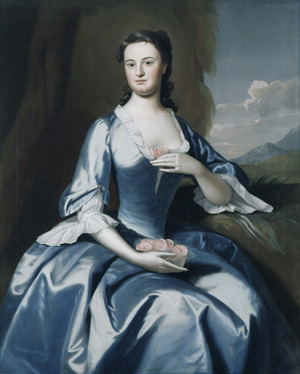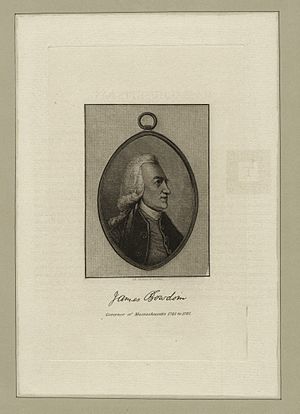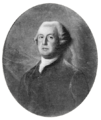James Bowdoin facts for kids
Quick facts for kids
James Bowdoin
|
|
|---|---|
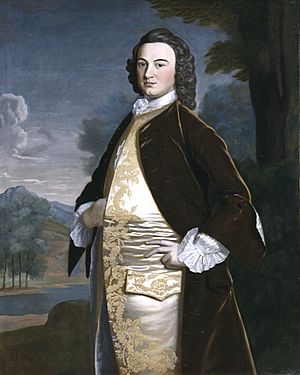
Portrait by Robert Feke, 1748
|
|
| 2nd Governor of Massachusetts | |
| In office May 27, 1785 – May 30, 1787 |
|
| Lieutenant | Thomas Cushing |
| Preceded by | Thomas Cushing (as acting governor) |
| Succeeded by | John Hancock |
| Personal details | |
| Born | August 7, 1726 Boston, Massachusetts, British America |
| Died | November 6, 1790 (aged 64) Boston, Massachusetts, U.S. |
| Political party | None |
| Spouse |
Elizabeth Erving
(m. 1748) |
| Children | 2 |
| Signature | |
James Bowdoin II (born August 7, 1726 – died November 6, 1790) was an important American leader from Boston, Massachusetts. He lived during the exciting time of the American Revolution and the years that followed. He first became well-known as a rich merchant.
Bowdoin served in the Massachusetts government from the 1750s to the 1770s. At first, he supported the British governors. But he soon disagreed with British rules for the colonies. He became a strong supporter of American independence. He wrote a very important report about the 1770 Boston Massacre. Many people say this report helped shape public opinion in the colonies.
From 1775 to 1777, he was the head of the Massachusetts government. He also led the group that wrote the state's constitution in 1779. In 1785, he was elected governor of Massachusetts. The state had a lot of debt from the Revolutionary War. Bowdoin promised to manage the state's money carefully. But tough economic times and his strict money policies led to an uprising called Shays' Rebellion. Bowdoin used his own money to help pay for soldiers to stop the rebellion. His actions might have caused him to lose the next election in 1787 to John Hancock.
Besides politics, Bowdoin loved science. He worked with Benjamin Franklin on his studies of electricity. He was chosen as a member of the Royal Society in London. He also helped start the American Academy of Arts and Sciences and was its first president. He gave his large library to this group. Later, Bowdoin College in Maine was named after him. This happened because his son, James Bowdoin III, gave money to the college.
Template:TOC limit=3
Contents
Early Life and Family
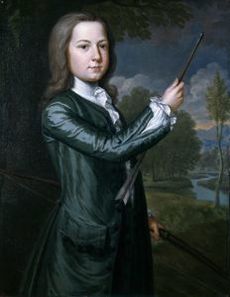
James Bowdoin II was born in Boston. His parents were Hannah Portage Bowdoin and James Bowdoin, a wealthy merchant. His grandfather, Pierre Baudouin, was a Huguenot refugee from France. The family first went to Ireland, then to what is now Maine, and finally settled in Boston in 1690.
James Bowdoin I started with a small inheritance. But he grew his father's business and land to become one of the richest men in the area. Young James went to the South Grammar School, which is now Boston Latin School. He then graduated from Harvard College in 1745. When his father died in 1747, James inherited a lot of money. In 1748, he married Elizabeth Erving. They had two children.
A Man of Science and Business
James Bowdoin was very interested in science throughout his life. He may have met Benjamin Franklin as early as 1743. They became good friends and often wrote to each other about science. At Harvard, Bowdoin learned about science from John Winthrop. He became very interested in electricity and space.
In 1750, Bowdoin visited Franklin in Philadelphia. Bowdoin was curious about Franklin's electricity experiments. Franklin even asked Bowdoin for advice on papers he sent to the Royal Society. Some of Bowdoin's own letters were read to the Society. Bowdoin also helped get support for a trip to Newfoundland. This trip was to watch the 1761 transit of Venus across the sun. In the same year, he wrote a paper suggesting ways to make the telescope better.
In 1780, Bowdoin helped start the American Academy of Arts and Sciences. He was its first president until he died. He gave his library to the Academy. He also wrote poetry in both English and Latin. He received an honorary degree from the University of Edinburgh. In 1788, he became a member of the Royal Society of London. He was the first American to get this honor after the United States became independent.
Bowdoin also had many business dealings. He was often called a merchant, and he did trade across the Atlantic Ocean. But his main interest was in land. He inherited large areas of land, especially in what is now Maine. He also owned land on the Elizabeth Islands off the coast of Massachusetts. He bought more land, eventually owning property in almost all of New England.
He was one of the managers of a large area of land near the Kennebec River. He often had legal problems with people who built homes on his land without permission. These problems made Bowdoin dislike the poorer people in Massachusetts. This feeling affected his political views. He also owned an ironworks in Attleboro, which he sold in 1770. He found it too much work to manage.
Even during the American Revolution, Bowdoin was careful with his money. He supported the fight for independence financially. But he did so without hurting his own businesses. This was different from John Hancock, whose businesses suffered because he was so busy with politics. Later, in 1784, Bowdoin became the first president of the Massachusetts Bank. He was also the first president of the Massachusetts Humane Society. This group helped rescue people from shipwrecks.
Opposing British Rule
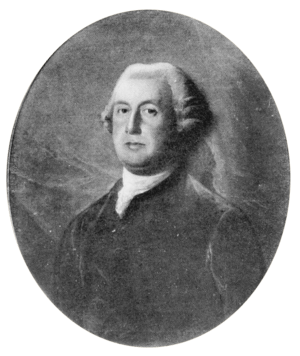
Bowdoin was elected to the Massachusetts assembly in 1753. In 1756, he was chosen to be on the governor's council. At first, he supported the royal governor. But his political views changed as British rules became more unpopular. Bowdoin believed these rules would hurt the economy of New England.
By 1769, Bowdoin was a main leader of the group that opposed the governor. That year, Governor Francis Bernard refused to let Bowdoin be re-elected to the council. However, Bowdoin played a key role in Bernard's removal from office. Private letters written by Bernard, criticizing the government, were published in 1769. This caused a lot of anger. Bowdoin wrote a strong pamphlet arguing that Bernard should be removed. This pamphlet was sent to the colonial secretary in Britain.
Bowdoin was re-elected to the assembly in 1770. He was quickly re-elected to the council that same year, after Bernard left. The new acting governor, Thomas Hutchinson, allowed Bowdoin to return to the council. Hutchinson thought Bowdoin would be less dangerous there than speaking out in the assembly. However, Samuel Adams, another strong opponent of the royal governors, took Bowdoin's old seat in the assembly. This meant Hutchinson faced opposition from both parts of the government.
After the Boston Massacre on March 5, 1770, Bowdoin was chosen to investigate the event. The committee gathered information and wrote a report called A Short Narrative of the Horrid Massacre. This report strongly criticized the governor and the British soldiers in Boston. It is seen as a major piece of writing that influenced public opinion in the colonies.
Bowdoin continued to oppose British policies under Governor Hutchinson. When Hutchinson's own letters were published, causing anger similar to Bernard's letters, Bowdoin again wrote strong criticisms. He called for Hutchinson's removal. In 1774, the next governor, General Thomas Gage, stopped Bowdoin from being re-elected to the council. Gage said he had "express orders from His Majesty" to keep Bowdoin out.
Leading Massachusetts
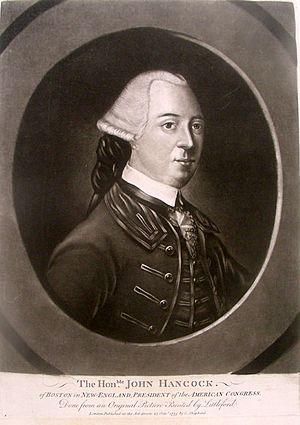
In 1774, Bowdoin was chosen to be a delegate to the First Continental Congress. But he did not go because his wife was very ill. He was also sick himself, probably with tuberculosis. In 1775, when the American Revolutionary War began, Bowdoin was still ill. His family moved from British-occupied Boston to Middleborough, where he lived until 1778.
Even though he was recovering, he stayed informed about events. He was elected president of the executive council of the Massachusetts Provincial Congress. This made him the unofficial head of the Massachusetts government until 1777. He resigned this position due to his poor health. He continued to write to other revolutionaries and was trusted by them. His absence from the war effort later caused him some political problems.
He started to return to public life in 1778. When Massachusetts wrote its own constitution in 1779, Bowdoin led the meeting that created it. He also chaired the committee that wrote the document. John Adams is usually given credit for writing most of the new constitution. But Bowdoin and Samuel Adams likely made important contributions too.
In the first election for governor in 1780, Bowdoin ran against John Hancock. There were no formal political parties then. So the election was about who was more popular and patriotic. Hancock was very popular. He was seen as a great patriot because of his personal sacrifices and leadership during the war. Hancock's supporters said Bowdoin was not patriotic enough. They pointed to his refusal to serve in the First Continental Congress, even though it was due to his illness.
Bowdoin's supporters were mostly wealthy business owners from coastal Massachusetts. They said Hancock was too showy and tried too hard to please the public. Hancock easily won the election, getting over 90% of the votes. The Massachusetts House of Representatives offered Bowdoin a lower position, but he refused due to his health. After the election, Hancock appointed him to a group that would update the state's laws.
Bowdoin ran against Hancock in later elections but could never beat Hancock's huge popularity. The competition between the two men was part of a long-standing rivalry. This rivalry included business, politics, and even religion. It seemed to be very personal. Both men were involved in running Harvard University, where their disagreements sometimes became unpleasant. For example, in 1776, a committee led by Bowdoin worried about Harvard's money held by Hancock. Hancock was slow to provide an accounting, and Bowdoin arranged for him to be criticized by Harvard's leaders.
In 1785, Hancock offered to resign as governor. He probably expected to be asked to stay. But the legislature did not ask him to, so he resigned, saying he was ill. The governor's race that year included Bowdoin, Lieutenant Governor Thomas Cushing, and General Benjamin Lincoln. The campaign was sometimes harsh. Bowdoin and Samuel Adams criticized Hancock's group. They focused on a new social club where card games and dancing took place. These activities had been banned in Boston. They said this showed a decline in morals under Hancock. Cushing's supporters accused Bowdoin of being a coward during the war.
No candidate won a majority of votes. So the legislature chose Bowdoin over the others after a very divided vote.
Shays' Rebellion and Its Aftermath
During his time in office, Governor Hancock had not strongly collected overdue taxes. Bowdoin, wanting to pay the state's foreign debts, raised taxes and pushed for collecting back taxes. These actions, along with a general economic downturn after the war and a shortage of money, caused big problems in the rural parts of the state. Meetings were held in rural areas, and people sent letters of protest to the state legislature. This legislature was mostly controlled by Bowdoin and wealthy merchants from the coast.

In July 1786, the legislature ended its session without really addressing these complaints. So, people in rural Massachusetts started to take direct action. They organized protests that shut down the state's court system. The courts were enforcing tax and debt judgments, which was a main cause of the anger. In early September, Bowdoin issued a statement against these actions. But he did not immediately organize soldiers to stop them.
When the court in Worcester was shut down by similar protests, the local soldiers refused to help Bowdoin. This disappointed him. Other courts were then closed in Concord and Taunton. By October, people were worried about a "Civil War." These court closings were similar to those in 1774, when colonists had shut down British business outside of Boston.
Fearing a new revolution, Bowdoin and the legislature passed a Riot Act. They also suspended habeas corpus, which protects people from unlawful imprisonment. By January 1787, the protests had become a direct attack on the Massachusetts government. Hampshire County became a center of the rebellion. Leaders like Daniel Shays and Luke Day began planning attacks on government buildings.
The federal government could not raise many soldiers. Bowdoin also could not trust the local soldiers in the western counties. So, in January 1787, he suggested creating a private army. This army would be paid for by merchants in the eastern part of the state. General Benjamin Lincoln raised money and men for this effort. By January 19, he had 3,000 men in Worcester.
On January 25, a confrontation at the Springfield Armory led to the deaths of several rebels. Lincoln then defeated the main rebel force on February 4 in Petersham. This ended the large-scale resistance. The same day Lincoln arrived in Petersham, the state legislature passed laws allowing the governor broad powers against the rebels. It also approved payments to repay Lincoln and the merchants who funded the army.
The harsh way the rebellion was put down hurt Governor Bowdoin politically. In the election in April 1787, Bowdoin received very few votes from the rural areas. He was easily defeated by John Hancock.
In 1788, Bowdoin was a member of the Massachusetts meeting that approved the United States Constitution. Bowdoin strongly supported the Constitution. He worked hard for its approval. He even convinced a doubtful Samuel Adams and his supporters to back it. Bowdoin's supporters also backed John Hancock in the 1789 election, even though Bowdoin was also running.
In his later years, he remained active in his charity and science work. He continued to lead the American Academy of Arts and Sciences and the Humane Society. He also started new businesses. In 1789, he bought a share in one of the first American merchant ships to sail to China.
Death and Legacy
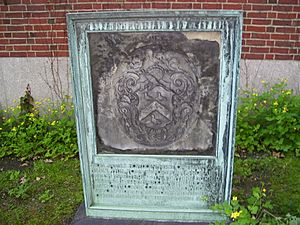
James Bowdoin died in Boston on November 6, 1790, after an illness. His funeral was one of the largest in Boston at that time. People lined the streets to watch the funeral procession. He was buried in Boston's Granary Burying Ground.
Among his gifts, he gave money to Harvard College for awards. These are now known as the Bowdoin Prizes. His son, James Bowdoin III, gave land from the family estate in Brunswick, Maine, along with money and books. This helped establish Bowdoin College in his honor.
An orrery (a model of the solar system) made by Joseph Pope includes bronze figures of Bowdoin and Benjamin Franklin. These figures were supposedly cast by Paul Revere. Bowdoin was responsible for saving the device when Pope's house caught fire in 1787.
Places named after Bowdoin in Boston include Bowdoin Street, Bowdoin Square, and the Bowdoin MBTA station. Bowdoin, Maine, was named for Bowdoin. Neighboring Bowdoinham, Maine was named for his grandfather Pierre or his brother William.
Images for kids
-
Portrait of Bowdoin as a child by John Smibert
-
Governor Francis Bernard
-
John Hancock (British mezzotint, 1775) was a perennial opponent of Bowdoin in matters political and personal.
-
This contemporary woodcut depicts two of the rebel leaders, Daniel Shays and Job Shattuck.
-
Bowdoin's tomb in the Granary Burying Ground


